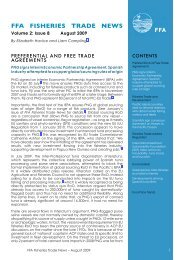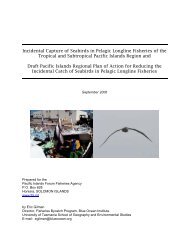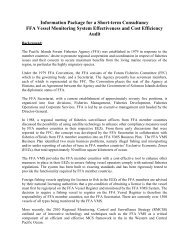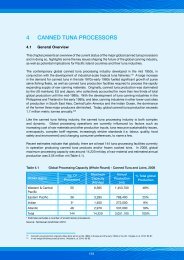Create successful ePaper yourself
Turn your PDF publications into a flip-book with our unique Google optimized e-Paper software.
P a c i f i c I s l a n d S p e c i e s<br />
<strong>SKIPJACK</strong> <strong>TUNA</strong><br />
- Katsuwonus pelamis<br />
Also known as: Aku, Atu, Atun, Bonite,<br />
Bonite á ventre rayé, Bonito, Banjo,<br />
Cachurreta, Faolua, Ga’oga Gaiado, Lesser<br />
Tunny, Listado, Merma, Mushmouth,<br />
Nzirru, Palamatu, Stripe Bellied Bonito,<br />
Striped Bellied Tunny, Tunna, Victor Fish.<br />
Hatchlings: A skipjack tuna hatchling of<br />
3 millimetres will feed on plankton and<br />
then small fish, crustaceans and molluscs<br />
to grow to 40cm in its first year.<br />
Skipjack tuna are fast and racy tuna -<br />
reaching sexual maturity in its first year,<br />
they will breed rapidly, one female tuna<br />
SCHOOL DAYS: Short-lived, fast-breeding skipjack tuna is a common sight<br />
in Pacific Island waters.<br />
creating 80,000 to 2 million eggs per<br />
year until they die at about 5 years old<br />
(maximum age is 8-12 years). Skipjack<br />
tuna heavy weights are around 20 kilos<br />
with most significantly smaller.<br />
School days: Where schools of skipjack<br />
tuna go varies widely and is thought<br />
to depend on ocean currents and<br />
temperatures with schools most enjoying<br />
water temperatures above 25 ˚C (68˚ F).<br />
Countries between Latitude 10˚N and<br />
10˚S are particularly rich in skipjack tuna<br />
schools. They like to travel with floating<br />
Masa Ushioda - SEAPICS<br />
objects or large marine mammals and<br />
often school according to size – so that<br />
tuna swimming together have the same<br />
speed for travelling and feeding.<br />
All the large predators such as sharks and<br />
billfish commonly prey on skipjack tuna.<br />
Reel life: Skipjack tuna can be caught<br />
on lines or in nets. They are commonly<br />
caught by Pacific Island pole-and-line<br />
fleets, Japanese pole-and-line fleets<br />
and domestic fleets in Indonesia and<br />
Philippines using a variety of methods.
PASSPORT<br />
<strong>SKIPJACK</strong> <strong>TUNA</strong><br />
PACIFIC ISLAND<br />
COUNTRIES<br />
WHERE<br />
<strong>SKIPJACK</strong><br />
SCHOOLS ARE:<br />
REEL LIFE: Skipjack tuna are mostly caught in large purse seine nets by non-Pacific Island countries.<br />
Small but locally important artisanal<br />
fisheries for skipjack and other tuna<br />
(using mainly trolling and traditional<br />
methods) occur in many of the Pacific<br />
Islands. Some Pacific Islands are looking<br />
at reviving pole and line fishing to meet<br />
local and niche markets.<br />
By far the most common way for<br />
skipjack tuna to be caught is in large<br />
purse seine nets by distant water<br />
fishing nation fleets from Japan, Korea,<br />
Taiwan and the USA in the Western and<br />
Central Pacific Ocean. Philippines and<br />
Indonesia made up to 20–25% of the<br />
total skipjack tuna catch in recent years.<br />
Stocks of skipjack tuna are considered<br />
abundant making up 70% of the total<br />
tuna catch in the Pacific Ocean. During<br />
the 1990s, annual catches from this<br />
region were about 500,000–800,000<br />
tonnes before increasing sharply to<br />
approach 1,000,000 tonnes in 2004–<br />
2006.<br />
Out of water: High quality sashimi<br />
skipjack tuna has deep red coloured<br />
flesh that becomes lighter when<br />
cooked. It has a stronger taste than<br />
other tunas and a short shelf life. It<br />
must be consumed 6 days after landing<br />
or the red flesh will quickly turn brown<br />
and soft.<br />
Most skipjack tuna is canned in<br />
Thailand, Vietnam and Philippines.<br />
Pacific Island countries of Samoa, PNG<br />
and Solomon Islands have also active<br />
canneries. Skipjack is also sold fresh and<br />
frozen.<br />
In Japan, skipjack tuna is known as<br />
katsuo, and is commonly smoked and<br />
dried to make katsuobushi the central<br />
ingredient in making dashi (fish stock).<br />
More Information:<br />
Oceanic Fisheries Management Project www.ffa.int/gef.<br />
Project queries email: barbara.hanchard@ffa.int, Media queries email: anouk.ride@ffa.int
















